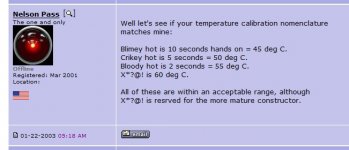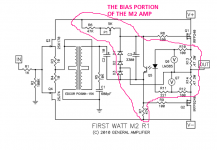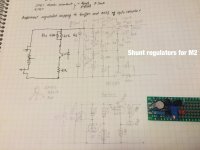Everything measures spot on. And it sounds great.
Maybe I am just paranoid. I like the sound of this amp, so I am concerned with long term reliability.
Maybe I should obtain some scientific infrared camera to measure the temperature.
Maybe I am just paranoid. I like the sound of this amp, so I am concerned with long term reliability.
Maybe I should obtain some scientific infrared camera to measure the temperature.
If the voltage across R13 measures spot on,
and if the voltage across R14 measures spot on,
then I would start to consider replacing the super hot MOSFET with a brand new fresh virgin device, and also replacing its thermal pad, and also replacing the bolt and fender washer which secures it to the heatsink.
and if the voltage across R14 measures spot on,
then I would start to consider replacing the super hot MOSFET with a brand new fresh virgin device, and also replacing its thermal pad, and also replacing the bolt and fender washer which secures it to the heatsink.
as you know - skin sensitivity is pretty hysterical in short range of temperature (with good reason)
that's why I said - for any objective conclusion , you need to make proper measurement of temperature for all mosfets in amp - ditto on mosfet body , then heatsink area nearby
only then we can make some conclusions
read attached , and think what I wrote in first sentence
that's why I said - for any objective conclusion , you need to make proper measurement of temperature for all mosfets in amp - ditto on mosfet body , then heatsink area nearby
only then we can make some conclusions
read attached , and think what I wrote in first sentence
Attachments
Ok, I have ordered infrared temperature meter. One with higher D:S ratios, so I can measure each particular spot. They have wide selection with reasonable prices.
I figured this will be useful in the future to know exactly the surface temp. No more burned fingers 🙂
Infrared Non-Contact Thermometers Archives - Calright
I figured this will be useful in the future to know exactly the surface temp. No more burned fingers 🙂
Infrared Non-Contact Thermometers Archives - Calright
If anyone interested. Having completed my M2 last year and greatly enjoyed it I succumbed to grass is greener syndrome and built and swapped in some F5 boards a month ago. I wanted a little more sparkle on the top from my M2/FH3/Pluvia 7 combo. Not quite what I expected. What I got was a much more analytical sound, positively dry by comparison. Maybe more detail, but the feeling - so what? I persisted, went through a hundred odd cd's and couldn't find much satisfaction. I bought an old REL T3, which gave another dimension, impressive but still the lack of involvement. So I swapped back in the M2 boards. Wow. Not too subtle an effect. I'm out of the desert and able to enjoy the music. It was a good recalibration exercise for my ears. In six moons terminology, I need that sauce on the salad.
PS B1 driving M2, protection resistor out, no jfets at input to M2 (straight into transformer). Anyway, 2 F5 boards for sale if anyone interested! Proper JFETS from punky dawgs.
PS B1 driving M2, protection resistor out, no jfets at input to M2 (straight into transformer). Anyway, 2 F5 boards for sale if anyone interested! Proper JFETS from punky dawgs.
My own experience with the commercial First Watt M2 is that it can be a bit elusive. I have found myself leaving it on either for a few hours or just all the time. It can sound good after some warm up, but it transitions somewhere after several hours of warm up to a more sublime condition.
I don't know why that would be, that it requires such a long warm up period to sound it's best, unless it is just the nature of the open loop, no feedback circuit. VFET amps, by comparison, can sound good with just a bit of warm up.
It is possible to turn M2 on, let it warm up for half an hour, and have a complete listening session without it ever reaching it's 'best' category. Weird. So, I think impressions of the M2 tend to vary around that. I just leave it on all the time when I plan to listen to it over a couple of days. Then, it can sound great at every session.
I don't know why that would be, that it requires such a long warm up period to sound it's best, unless it is just the nature of the open loop, no feedback circuit. VFET amps, by comparison, can sound good with just a bit of warm up.
It is possible to turn M2 on, let it warm up for half an hour, and have a complete listening session without it ever reaching it's 'best' category. Weird. So, I think impressions of the M2 tend to vary around that. I just leave it on all the time when I plan to listen to it over a couple of days. Then, it can sound great at every session.
It could be due to variation of the mains voltage. Bias current and DC offset change with rail voltage. Next time when your M2 is sounding the best take a measurement of your mains voltage. That may be the sweet spot. When it is not sounding good, take another measurement. See if there is a difference. What do you think?
For mine, I actually build a regulated supply for the bias portion of the M2 circuit so bias and dc offset do not change.
... I actually build a regulated supply for the bias portion of the M2 circuit so bias and dc offset do not change.
Very interesting!
Do you agree with me about what is the "bias portion" of the M2 circuit design? If so, where does the regulated supply connect?
Thank you.
_
Attachments
Cut trace from R6 towards + rail. Cut trace from R7 towards - rail. Connect regulated + supply to R6 and regulated - supply to R7
See photo of shunt regulator board. Sorry about the schematic. Only hand drawn. R6a was added so that I could adjust DC offset to zero.
Hey Kwee,
What transformer is that?
Looks interesting, maybe a good substitute for the Edcor.
what you cut from rails , you're cutting from max output amplitude
not big deal , anyway
most important is that you had fun 🙂
personally - I'm not finding as critical bias spread of (say) +/-100mA , when mosfet source follower OS is in case
not big deal , anyway
most important is that you had fun 🙂
personally - I'm not finding as critical bias spread of (say) +/-100mA , when mosfet source follower OS is in case
- Home
- Amplifiers
- Pass Labs
- Official M2 schematic





